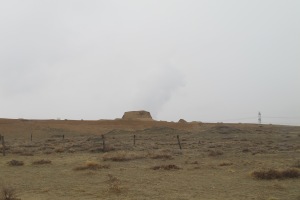More sightseeing in Ningxia Hui Autonomous Region
Our second day in Ningxia was full of history and sightseeing and some funny and rather sweet signs!!
Firstly we travelled some forty kilometres out of the capital Yinchuan to see the Western Xia Tombs. The tombs include nine imperial mausoleums and there are also 250 tombs of imperial relations and officials. This dynasty (Western Xia) existed between 1038 and 1227 after which it was conquered by the Mongols under Genghis Khan. This area holds so much history and our guide gave us a great history lesson.
Our next stop was to Shuidonggou which is one of the oldest ruins in China. On our way we stopped to see an old part of the Great Wall built in the Ming Dynasty. We saw what were referred to as ‘temples’ still in tact and said to be for the troops stationed along the Wall but also for locals and the guards to offer sacrifices to the gods. There were also beacon fire stations along the Wall which were used by the troops to advise of enemy movement through the lighting of fires – there were 615 of these beacons along this part of the Wall during the Ming Dynasty.
Shuidonggou is said to have been inhabited by humans 30,000 years ago. French palaeontologists discovered the palaeolithic site in 1923 finding over 50,000 artefacts, stone tools and fossils. The majority of the finds are located in the local museum.
However there was a very interesting find in 2007 when the skeletons of a male and female were discovered under the sand where a temple was previously standing. There have been many versions of how death occurred including murder and earthquake as it is said that the deaths were sudden. Both skeletons are encased in glass available for viewing.
We then stopped for lunch at a lovely little ‘communist’ restaurant and by that I mean it had photos of communist leaders around the world, up on the wall and we were given a little book on communism in China to use as a note pad when we left. Food was great – a huge bowl of wheat noodles with vegetables – I could only eat a quarter as it was so big.
My friend tried the local sweet tea which did look good but was a little too sweet for me.
Then we proceeded to Hongshan Fort, built during the Ming Dynasty (AD 1521) which housed an army general and his troops. The underground barracks have now been excavated and are accessible to visitors. They were really amazing; long corridors with dug outs for soldiers to stand guard and meeting rooms for planning. There was a separate suite for the general which contained bedroom/kitchen/sitting room and secret access door through the wardrobe for escaping.
It was a great day; albeit long, but definitely worthwhile.

















Great stories!! Your trip really is special, it’s not some place that would be a first choice for just any traveller! 🙂
LikeLiked by 1 person
Such an interesting place to visit.
LikeLiked by 1 person
It was interesting and funny signs alright 🙂
LikeLiked by 1 person
Great post. Thanks 🙂
LikeLiked by 1 person
What a great site to visit, so many interesting facts and artefacts about it’s history 🙂
LikeLiked by 1 person
Truly an amazing place to visit! Thank you for the virtual tour.
Enjoy reading the historical information. 🙂
LikeLiked by 1 person
Guess Marx and Engels would be shocked to see how they are paraded next to mass murderers:p
Such old ruins are always fascinating to visit and you got to love the escape route through the wardrobe, should plan something like that myself for a future house!
LikeLiked by 1 person
It’s so cool how you get to travel around those remote places in China! I’m a great tea lover so I’d love to try that tea, it looks very extraordinary 🙂
LikeLiked by 1 person
Fascinating history. Love the signs!
LikeLiked by 1 person
I’d love to go to these places! Could you also check out my blog?😘
LikeLiked by 1 person
Archaeology site, what a great place to visit!
LikeLiked by 1 person
Ha ha agree.
LikeLiked by 1 person
Thank you it was great.
LikeLiked by 1 person